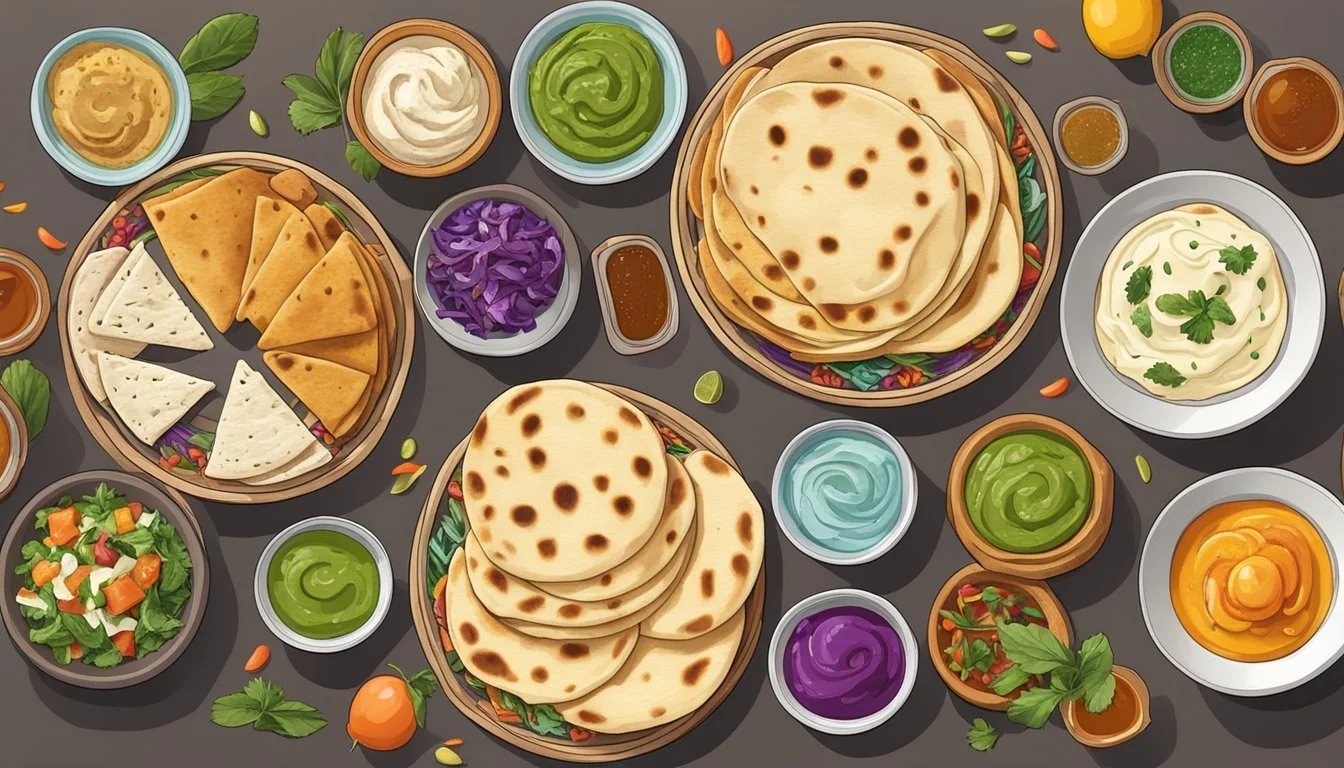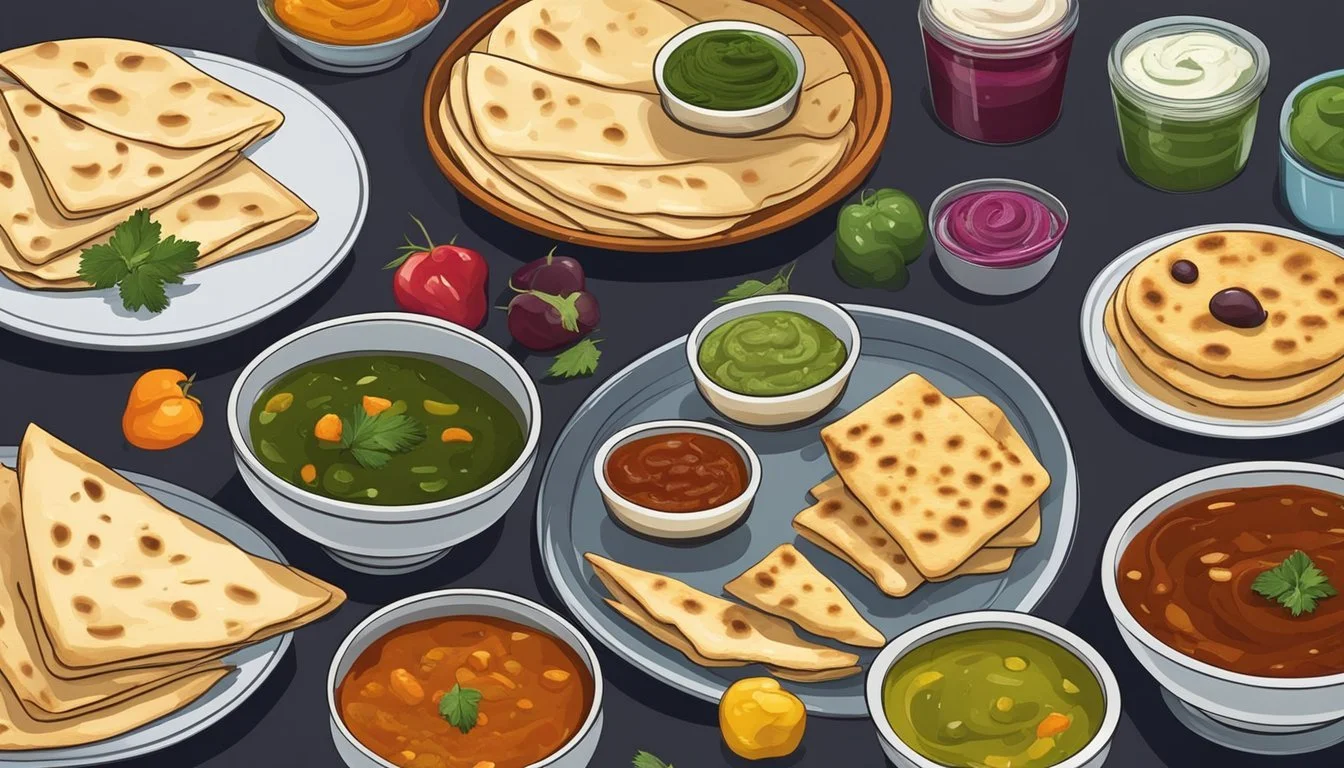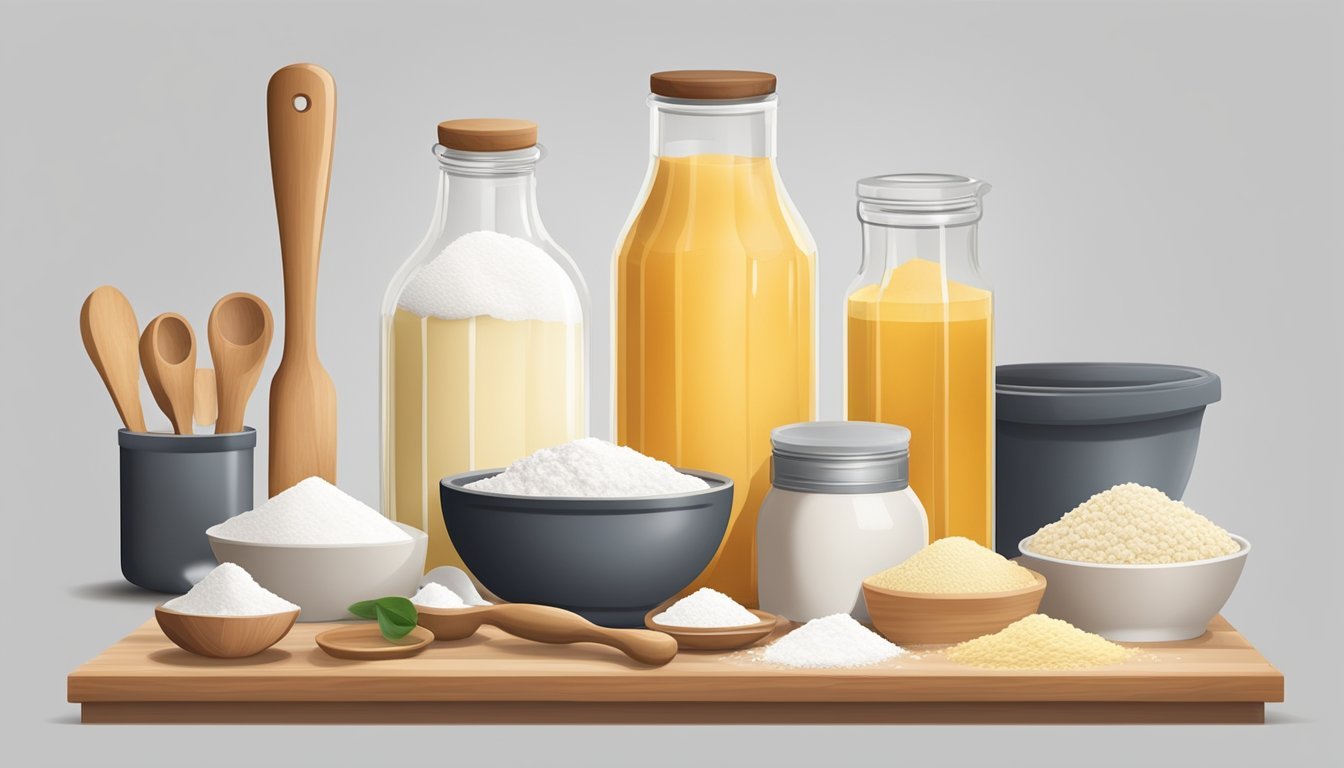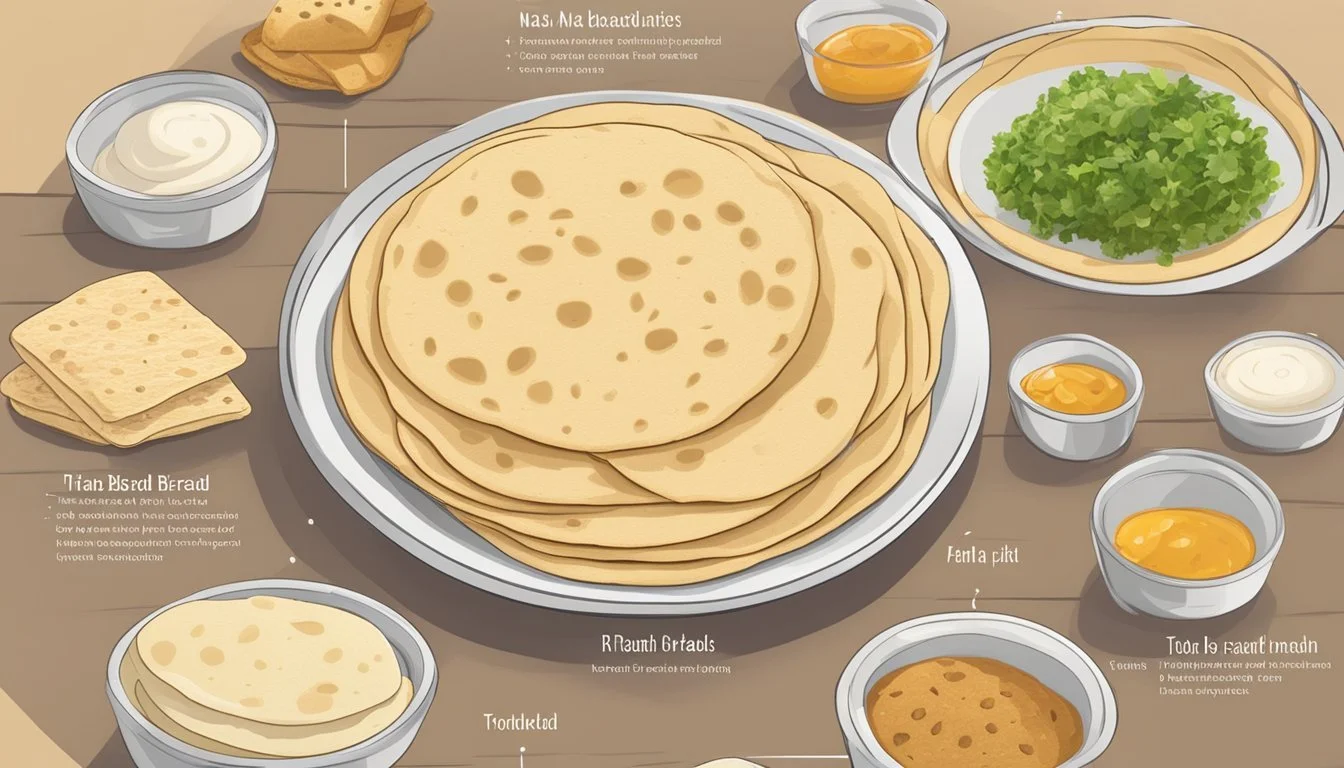Naan Bread Substitutes
Top Alternatives for Your Curry Nights
Naan bread, a staple in Indian cuisine, is celebrated for its fluffy texture and delicious taste. Traditional naan is a leavened, oven-baked flatbread, typically made in a clay tandoor. This bread, integral to the culinary traditions of India, often accompanies spicy curries and savory dishes, serving as a versatile and essential component of Indian meals.
For those without access to a tandoor or for anyone looking to explore different culinary traditions, there are several substitutes that maintain the spirit of naan while providing distinct flavors and textures. Flatbreads such as roti and paratha, similar to naan in their Indian origins, present an easy alternative, as do puri, pita bread, and tortillas which are more readily available globally.
These alternatives not only offer a practical solution when naan bread is not within reach but also add variety to meals with their unique characteristics. Whether it's the soft and pliable nature of tortillas or the whole grain and gluten-free options abundant in health-conscious circles, there is no shortage of options for those looking to replicate or replace the experience of naan bread in their cuisine.
Understanding Naan Bread
In exploring naan bread as a staple of South Asian cuisine, attention to its key ingredients, traditional preparation methods, and nutritional content reveals why this food is both cherished and distinct.
Key Ingredients
Flour: The primary ingredient in naan bread is generally refined wheat flour, although variations can include whole wheat or gluten-free alternatives for dietary preferences.
Yeast: Active dry yeast is commonly used to leaven naan, contributing to its characteristic texture.
Oil: Various oils or ghee (clarified butter) are integral, lending richness and moisture.
Salt and Sugar: Small amounts of salt and sugar enhance flavor and can affect yeast activity.
The dough, which combines these ingredients, is essential to naan's structure and texture.
Traditional Preparation Techniques
Dough Formation: Yeast, flour, oil, salt, sugar, and water are kneaded to form a soft, pliable dough.
Resting and Rising: The dough is left to rise, allowing gluten development and yeast fermentation.
Shape and Cook: Traditionally, the dough is rolled into a tear shape and slapped onto the walls of a tandoor, a high-heat clay oven, achieving distinct bubbles and char.
This cooking method imparts a smoky flavor and unique texture that distinguishes naan from other breads.
Nutritional Profile
Nutrient Typical Quantity Calories Varies by size and recipe; a white naan can contain more calories than two slices of white bread due to its density. Protein Moderate; it contributes to the chewy texture. Fiber Low in traditional white naan; whole-wheat versions offer more. Iron and Magnesium Present due to the flour, with content varying based on the type. Vitamins Minimal unless fortified flour is used. Glycemic Index Typically high, which can influence blood sugar levels.
Naan bread provides a moderate amount of protein but can be high in calories and have a substantial effect on blood sugar levels, attributing to its high glycemic index. It also contributes minerals such as iron and magnesium.
Substitutes for Naan Bread
When seeking alternatives to naan bread, one must consider texture, flavor, and dietary preferences. The following options provide a versatile range of substitutes that cater to various needs, including gluten-free choices and options that prioritize health and nutrition.
Flatbread Alternatives
Flatbreads make excellent substitutes for naan due to their similar texture and versatility. Pita bread and tortilla stand out as convenient options. Pita bread has a light texture and a pocket that is ideal for fillings, while tortillas, especially made from whole wheat flour, offer a durable and flexible base that can be used in a myriad of dishes. Roti, another flatbread, offers a wheat-based alternative that pairs well with traditional dishes that typically accompany naan.
Pita Bread: Light, pocketed bread for fillings and dips.
Tortilla: Flexible, whole wheat option that is low in saturated fat.
Roti: Whole wheat Indian bread, suitable for scooping curries.
Gluten-Free Options
Individuals with gluten sensitivities can opt for gluten-free recipes that modify traditional naan to align with their dietary requirements. A blend of gluten-free flour and tapioca flour, along with baking powder and salt, can act as the foundation for a naan substitute. Addition of dairy-free yogurt to this mixture can result in dough that mimics the softness and elasticity of traditional naan.
Gluten-Free Flour Blend: Base for dough to create allergen-friendly naan.
Tapioca Flour: Provides the chewy texture desired in flatbreads.
Healthy and Nutritious Substitutes
For those seeking a healthier alternative, there are ingredients that can be substituted in naan recipes to improve their nutritional profile. Substituting high-fiber flours or using nut butters like almond or cashew butter can enhance the flavor while offering more vitamins and less sodium. These modifications can yield a product that is not only tasty but also beneficial for overall health.
High-Fiber Flours: Increase fiber content, valuable for digestion.
Nut Butters: Add protein and healthy fats, reducing saturated fat intake.
Accompaniments and Uses of Naan
Naan bread, with its soft texture and slight chew, is versatile in culinary uses, ranging from traditional Indian pairings to inventive global dishes that satisfy various dietary preferences.
Traditional Pairings
Naan bread is traditionally served warm and often brushed with ghee or butter to enhance its flavor. It acts as a staple side dish in Indian cuisine, perfect for mopping up rich gravies. Saag, a spiced spinach and greens dish, and various forms of kebabs are commonly accompanied by naan. The bread's mild taste and pillowy consistency make it ideal for balancing the bold spices and herbs iconic to these dishes.
Modern Twists and Combinations
Modern culinary trends have expanded the uses of naan beyond traditional side dishes. It's commonly seen as the base for pizza crusts, where it's topped with a variety of sauces, cheeses, and toppings for a quick and flavorful meal. Naan can also be sliced and used as a base for sandwiches or stuffed with fillings. For those following a vegan diet, naan replaces pita in hummus or other dips. Additionally, varieties like garlic naan amplify the flavor profile of even the simplest pairings, making it a dynamic component in fusion dishes.
Customizing Naan Bread Substitutes
Customizing naan bread substitutes with dairy-free and vegan options, as well as the infusion of spices and herbs, allows individuals with dietary restrictions or preferences to enjoy variations of this traditional bread. Adaptations using simple ingredients can mimic the desired fluffy texture and flavor profile of naan.
Dairy-Free and Vegan Variations
For those avoiding dairy, traditional dairy products like milk and yogurt can be replaced with non-dairy alternatives. Here are some specific substitutions:
Milk: Replace cow's milk with almond milk or coconut milk to achieve a similar consistency without lactose. Almond milk imparts a nutty flavor, while coconut milk can lend a subtle sweetness.
Yogurt: Greek yogurt in naan can be substituted with dairy-free yogurt variants. Opting for coconut or almond-based yogurts can maintain the naan's soft texture, and these vegan alternatives often work well in the proofing process.
Using these dairy-free substitutes not only caters to vegans but also to those with lactose intolerance or a preference for plant-based diets.
Incorporating Spices and Herbs
Adding spices and herbs to naan bread can enhance its flavor and complement the accompaniments. Consider the following:
Turmeric: A pinch of turmeric can add a warm, earthy flavor and a golden hue.
Curry Powder: For a spicier note, a teaspoon of curry powder will give the naan a distinct aroma.
Basil: Chopped basil leaves can provide a fresh, herby brightness to the bread.
Incorporating these elements not only boosts the taste but also introduces a new dimension to classic naan, making it a versatile component in various culinary traditions.
Preparation Tips for Naan Substitutes
When considering naan substitutes, the preparation process is critical whether one opts for a homemade creation or a store-bought solution. Specific techniques and ingredients contribute to achieving the desired softness or crispiness.
Homemade Options
For those aiming to craft naan substitutes at home, beginning with the right mixture is essential. One can start with a mixing bowl, combining gluten-free flour blend with baking powder and a pinch of salt, which are the foundations of many naan recipes. Warm water is often a key component, introduced to the dry mix alongside dairy-free yogurt or a nut-based butter like cashew or peanut to create the dough.
The dough generally needs rest to allow the ingredients to fully integrate. Kneading is an important step too, as it contributes to the texture of the finished bread. Once rested and kneaded, dividing the dough and rolling it into thin, flat shapes prepares them for cooking.
A cast-iron skillet or tawa serves well to imbue a crisp exterior, resembling the traditional naan's charred spots. Cook the dough over a medium to high flame until pockets of air begin to form, and the surface attains a golden brown hue. One innovative tip is to sprinkle sesame seeds onto the bread before it heats, adding a subtle nutty flavor and extra texture.
Store-Bought Solutions
When convenience is a priority,store-bought alternatives present an easy to make option for those craving the essence of naan with minimal effort. It is imperative to read the heating instructions carefully as each product may require different methods, such as baking in an oven or warming in a microwave.
Many pre-made flatbreads benefit from a brief stint in a skillet to elevate their texture to that which is reminiscent of fresh naan – soft yet with a slight crispness. It's advisable to warm these breads just before serving to ensure they retain their moisture and elasticity.
In both homemade and store-bought cases, having a warm accompaniment ready, such as a stew or curry, ensures that the substitute naan is enjoyed in the way it was intended, as a delicious vehicle for savory flavors.
Health Considerations When Choosing Substitutes
When looking into healthier alternatives to naan bread, calorie content, and the impact on blood sugar levels are paramount, especially for individuals managing weight or diabetes.
Low-Calorie Choices
For those counting calories, roti can be a lower-calorie alternative to naan. Roti is typically made from whole wheat flour and water, with no added oils that are commonly found in naan, reducing the overall caloric intake. Another low-calorie option includes lettuce cups, which can be used as wraps in place of bread. Lettuce cups are particularly low in calories while still providing a satisfying crunch and freshness to the meal. Additionally, rice paper sheets used in making spring rolls are low in calories and can provide a novel, yet healthy, twist to traditional selections.
Options for Diabetic-Friendly Diets
Substitutes that support stable blood sugar levels are critical for a diabetic-friendly diet. Roti, particularly when made with whole wheat flour, offers a more complex carbohydrate profile and fiber, which can help in managing the glycemic index of the meal. Corn tortillas, on the other hand, can be a good alternative due to their lower glycemic index compared to breads made with refined flour, reducing the risk of blood sugar spikes. It's also beneficial to consider alternative flour options such as almond flour products, which are lower in carbohydrates and thus less likely to affect glucose levels. For individuals who are lactose intolerant or avoiding gluten, options like gluten-free flatbreads made from almond flour or other gluten-free blends can be an excellent substitute, avoiding the discomfort associated with these sensitivities while also aiding in cholesterol management.







